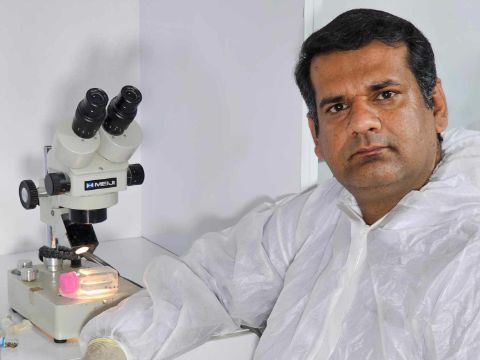- Charles Sturt University research has discovered a new parasite in rare fish in a remote area of Iran enabling description of the parasite before it and the host fish disappear forever
- Parasites play vital roles in maintaining the structure and functioning of ecosystems and also serve as valuable indicators of ecosystem health
- Preserving parasite species is just as important as saving the charismatic vertebrates that typically receive the majority of conservation attention and funding
Research led by Charles Sturt University has discovered a new parasite in rare fish in drying reservoirs in a remote area of Iran near the Afghanistan border.
Details of the study, ‘Gill parasites of Schizocypris altidorsalis (Pisces: Cyprinidae), a threatened freshwater fish in Iran’, were recently published in Marine and Freshwater Research (CSIRO Publishing, March 2024).
The research team was led by Professor in Veterinary Parasitology Shokoofeh Shamsi (pictured top) in the Charles Sturt School of Agricultural, Environmental and Veterinary Sciences and the Charles Sturt Gulbali Research Institute for Agriculture, Water and Environment.
Professor Shamsi, who conducted some of the research in the University’s National Life Science Hub (NaLSH) in Wagga Wagga, said the new species, named Paradiplozoon jalalii in honor of Professor Behiar Jalali (1953–2010), is an intriguing creature.
“It is unique in many aspects; two parasites come together, fuse, and coexist for the duration of their lives,” Professor Shamsi said. “Each parasite possesses both male and female reproductive parts, yet they merge and function as one entity; they look like a butterfly.”
 Paradiplozoon jalalii inhabit the gills of a freshwater fish (Schizocypris altidorsalis, locally known as ‘anjak’) which only inhabit arid landscapes bordering Iran and Afghanistan.
Paradiplozoon jalalii inhabit the gills of a freshwater fish (Schizocypris altidorsalis, locally known as ‘anjak’) which only inhabit arid landscapes bordering Iran and Afghanistan.
Both the fish and the new parasite species are found exclusively in drying water reservoirs.
The fish host, ‘anjak’, is a popular fish among local people, and the region in which it is found is a very isolated and deprived region even by the standard of developing countries.
The drying water reservoirs pose a threat to both the fish and the newly discovered butterfly-like species, placing them at risk of extinction.
“We are lucky that we could see and describe the parasite before the parasite and the host fish disappear forever,” Professor Shamsi said.
“Unfortunately, many species like these go unnoticed internationally as they are not listed as vulnerable or endangered.
“This oversight extends to various countries worldwide, leaving numerous species vulnerable to extinction without proper recognition and protection.”
Professor Shamsi said there are dedicated and passionate animal health scientists in Iran who were an instrumental part of this study.
 The study, a collaboration by the researchers at Charles Sturt in Wagga Wagga and the Faculty of Veterinary Medicine at Ferdowsi University of Mashhad in Iran, is a comprehensive investigation into the occurrence and diversity of the host-specific parasite group Monogenea on the fish Schizocypris altidorsalis.
The study, a collaboration by the researchers at Charles Sturt in Wagga Wagga and the Faculty of Veterinary Medicine at Ferdowsi University of Mashhad in Iran, is a comprehensive investigation into the occurrence and diversity of the host-specific parasite group Monogenea on the fish Schizocypris altidorsalis.
It provides detailed information about the fish host, and identification of the parasite which is a lengthy and highly detailed exercise due to the microscopic size of the taxonomically important features of the parasite.
“Gill parasites, such as Monogenea, are important since they impact fish health,” Professor Shamsi said. “The gills play several vital roles in fish, including respiratory and excretory functions.
“Infections by parasites can disrupt these crucial systems, resulting in malfunctions and, consequently, significant health problems for the fish.
“Monogeneans are highly specialised host-specific parasites infecting fish gills that can adversely affect respiration and excretory functions in fish, making them more vulnerable to illness, leading to population declines.”
Professor Shamsi highlighted the challenges of determining effective strategies for safeguarding endangered fish in conflict zones, such as the area studied here.
“In addition, the parasite identified in the study, with its blood-feeding habits, could contribute to the extinction of its fish host, subsequently leading to its own extinction,” she said.
“This raises an unanswered question regarding the potential extinction of other symbionts of Schizocypris altidorsalis if the fish faces extinction and the potential implications for the fish’s survival and conservation.”






Social
Explore the world of social